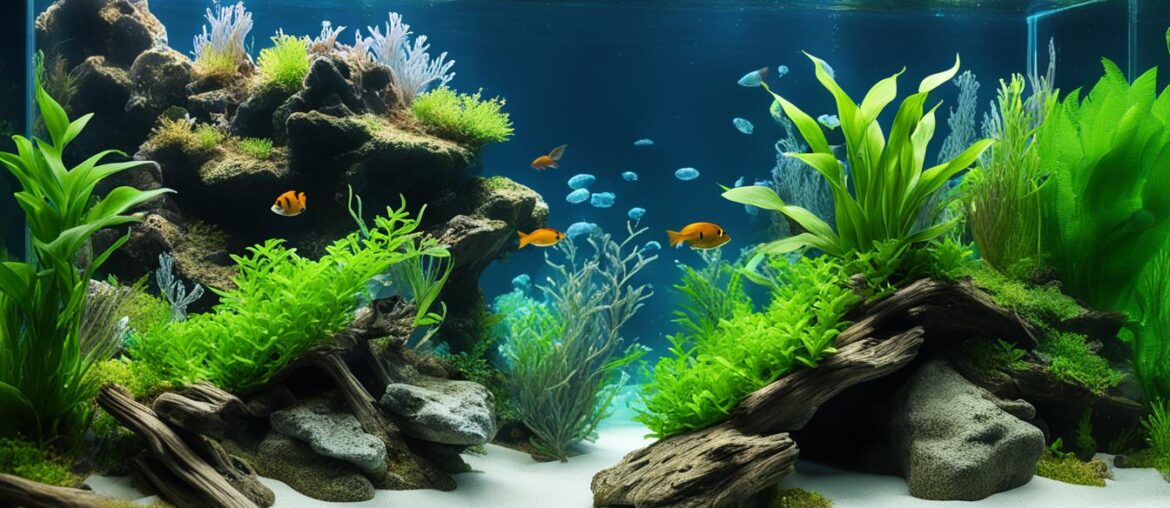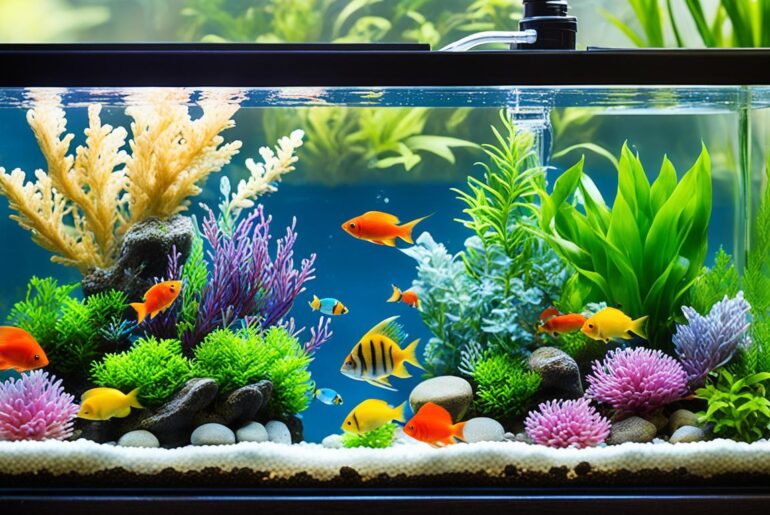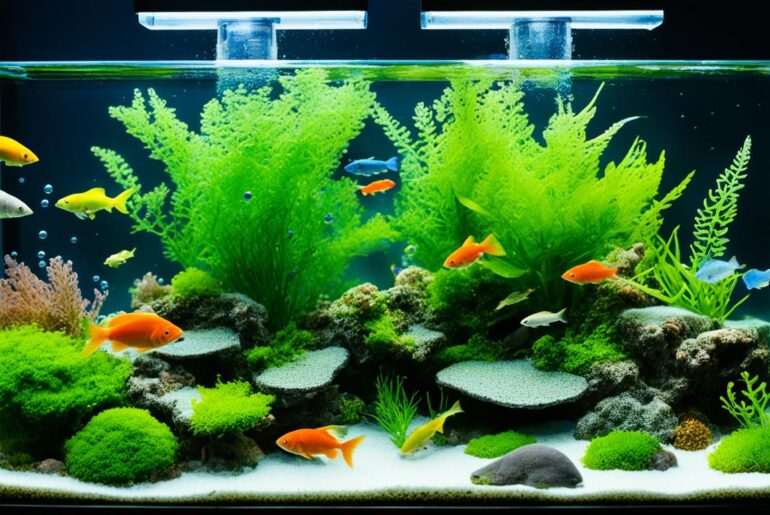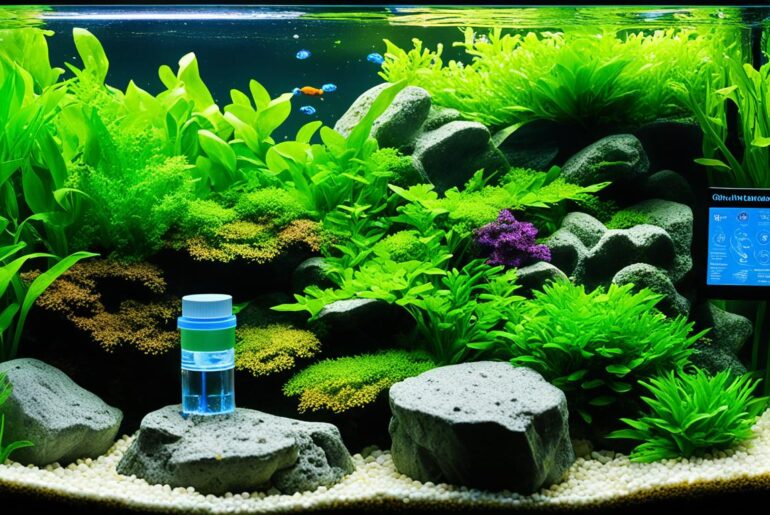As a lifelong lover of aquatic life, I’ve always dreamed of having my own aquarium. The beauty and tranquility of a well-maintained tank filled with colorful fish and vibrant plants is truly mesmerizing. So, when I finally decided to take the plunge and set up my new aquarium, I was filled with excitement and anticipation.
My vision was clear – I wanted to create a thriving ecosystem that would not only provide a safe and healthy environment for my fish but also showcase the natural beauty of aquatic plants. I knew that cycling my aquarium with plants would be a crucial step in achieving this goal. It would establish a biologically balanced tank and promote the growth of beneficial bacteria that are essential for maintaining water quality.
Embarking on this journey, I faced challenges and learned valuable lessons along the way. Through trial and error, I discovered the most effective techniques for cycling a new aquarium with plants, and I want to share my knowledge with you. Whether you’re a beginner or an experienced aquarist, this 7-step guide will help you create a stunning underwater paradise that both you and your fish will love.
Key Takeaways:
- Cycling a new aquarium with plants is vital for creating a healthy and balanced ecosystem.
- Properly cycling your tank promotes the growth of beneficial bacteria and regulates the nitrogen cycle.
- By following a comprehensive 7-step guide, you can establish an environment that ensures the well-being of your fish.
- Cycling can be done with or without fish, and both methods have their advantages and considerations.
- Patience, observation, and regular monitoring of water parameters are essential for successful cycling with plants.
What is Aquarium Cycling?
Aquarium cycling is the process of creating a biologically safe environment for fish in a new tank. It involves introducing nitrifying bacteria into the aquarium to regulate the nitrogen cycle. The nitrogen cycle is the natural process by which toxic ammonia produced by fish waste is converted into less harmful substances, such as nitrite and nitrate, through the activity of beneficial bacteria.
This cycle is vital for the health and well-being of your fish, as it helps maintain water quality and prevents the buildup of harmful toxins. Without proper aquarium cycling, ammonia levels can rise, posing a significant risk to fish. By establishing a balanced nitrogen cycle, you create a stable and healthy aquatic environment for your fish to thrive.
During aquarium cycling, the nitrifying bacteria play a crucial role. These bacteria convert ammonia, which is highly toxic to fish, into nitrite. Nitrite is also harmful to fish but is less toxic compared to ammonia. Finally, another group of beneficial bacteria convert nitrite into nitrate, which is relatively harmless to fish but can be removed through regular water changes.
By completing the aquarium cycling process, you establish a natural balance of bacteria in your tank that continuously breaks down fish waste and maintains water parameters within safe limits. This ensures the well-being and longevity of your fish inhabitants.
Why is Aquarium Cycling Important?
Aquarium cycling plays a vital role in ensuring the long-term health and survival of your fish. By properly cycling your aquarium, you provide a conducive environment for nitrifying bacteria to establish and populate the biological filters. These beneficial bacteria are responsible for breaking down and removing the toxic ammonia produced by fish waste. Without a properly cycled aquarium, ammonia levels can quickly rise, posing a serious threat to the well-being of your fish.
One significant consequence of inadequate aquarium cycling is the occurrence of “New Tank Syndrome,” which can have detrimental effects on fish health. This syndrome refers to a condition where fish undergo stress or even die due to high levels of ammonia. It is particularly detrimental to fish that are not considered hardy or familiar with new environments.
To avoid this scenario and ensure the well-being of your fish, it is crucial to prioritize aquarium cycling as an essential step in maintaining a healthy and thriving aquatic ecosystem.
How Long Does Aquarium Cycling Take?
The duration of aquarium cycling can vary depending on several factors, including the size of the tank and the water’s pH and temperature. Generally, aquariums take four to eight weeks to cycle, but this timeframe can be influenced by the specific conditions of your tank.
It is important to closely monitor the temperature and pH of the water during the cycling process, as well as regularly test the levels of ammonia, nitrite, and nitrate. When the ammonia and nitrite levels reach zero and nitrates are being produced, the cycle is considered complete.
To ensure a successful cycling process, it is crucial to maintain stable water conditions and regularly test the water to ensure the levels of ammonia, nitrite, and nitrate are within appropriate ranges.
In the table below, you can find some factors that may affect the duration of aquarium cycling:
| Factors Affecting Aquarium Cycling | Duration |
|---|---|
| Tank Size | 4-8 weeks |
| pH | |
| Temperature | |
| Water Testing (ammonia, nitrite, nitrate) | Completion |
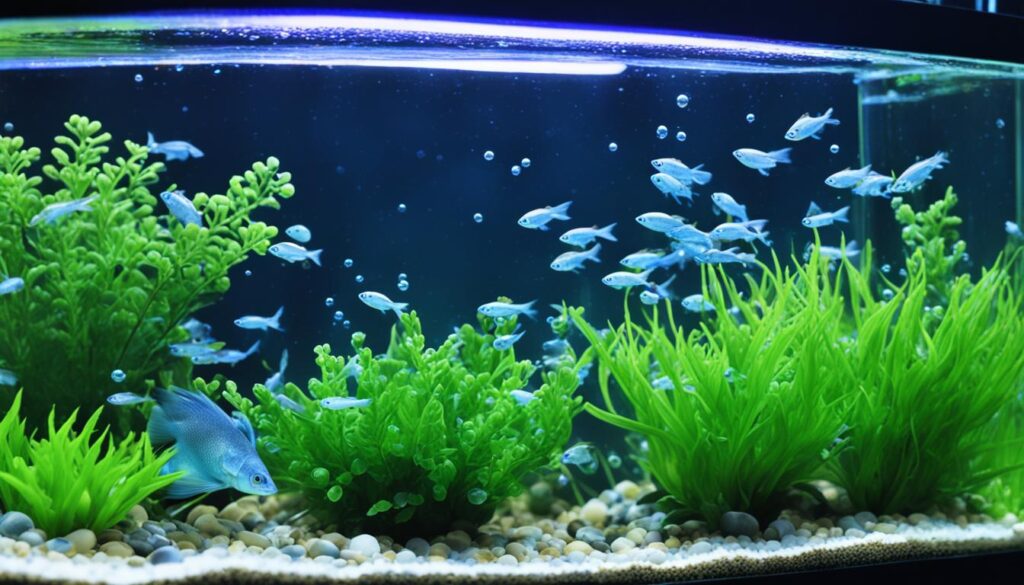
Monitoring and controlling these factors will help create an optimal environment for the growth of beneficial bacteria and a successful cycling process.
“Proper monitoring of water parameters and regular testing are essential during the aquarium cycling process. Reaching zero ammonia and nitrite levels and the presence of nitrates indicate a completed cycle, ensuring a safe environment for fish.”
What Do You Need to Cycle an Aquarium?
Before cycling your aquarium, it’s important to have the necessary supplies ready. Here’s a checklist of essential items:
Cycling Supplies:
- Fish food
- Aquarium test kit
- Aquarium components (pumps, filters, substrate, etc.)
- Water filter (preferably reverse osmosis)
Having these items prepared beforehand will make the cycling process smoother and more efficient. Let’s take a closer look at each of these supplies:
Fish Food: Choose a high-quality fish food that provides the necessary nutrients for your aquatic pets. Feeding your fish during the cycling process helps stimulate the growth of beneficial bacteria.
Aquarium Test Kit: An aquarium test kit is essential for monitoring and maintaining proper water parameters. It allows you to measure levels of ammonia, nitrite, nitrate, pH, and other important factors to ensure a healthy environment for your fish.
Aquarium Components: The right aquarium components, such as pumps, filters, and substrate, are crucial for establishing a well-functioning system. They provide necessary filtration and create a suitable habitat for fish and beneficial bacteria.
Water Filter: A quality water filter, preferably one that utilizes reverse osmosis, helps remove contaminants that can affect the nitrogen cycle. Clean water is essential for maintaining the overall health and well-being of your fish.
By having these cycling supplies ready, you’ll be well-prepared to establish a healthy and thriving aquarium ecosystem.
Cycling Without Fish
Cycling an aquarium without fish is a popular and recommended method, especially for beginners. This approach allows for a safer and controlled environment for the initial stages of the cycling process. By following a few simple steps, you can successfully cycle your tank without the need for fish.
Benefits of Fishless Cycling
Fishless cycling offers several benefits. Firstly, it eliminates the risk of harming fish during the cycling process, ensuring their well-being from the start. Secondly, it allows for better control over water parameters, as fish produce variable amounts of waste that can impact cycling. Lastly, fishless cycling creates a stable and balanced ecosystem, providing a healthier environment for your fish in the long run.
Steps for Fishless Cycling
The following steps outline the process of fishless cycling:
- Setting up tank components: Install filters, substrate, and any additional equipment required for your aquarium.
- Checking water pH: Use a reliable pH test kit to ensure the water pH is suitable for beneficial bacteria growth.
- Adding ammonia: Introduce a source of ammonia, such as ammonium chloride, to initiate the nitrogen cycle.
- Monitoring ammonia and nitrite levels: Regularly test the water for ammonia and nitrite levels to track the progress of the cycling process.
- Checking nitrate levels: Monitor nitrate levels in the tank, as the presence of nitrates indicates that the cycle is nearing completion.
- Introducing fish: Once the ammonia and nitrite levels reach zero and nitrates are being produced, the tank is considered cycled. Gradually introduce fish to the tank, starting with small, hardy species.
By following these steps, you can successfully and safely cycle your aquarium without fish, creating a healthy environment for your aquatic pets.
Example Table: Monitoring Water Parameters
| Time | Ammonia Level | Nitrite Level | Nitrate Level |
|---|---|---|---|
| Week 1 | 4 ppm | 0 ppm | 0 ppm |
| Week 2 | 4 ppm | 0.5 ppm | 0 ppm |
| Week 3 | 2 ppm | 1 ppm | 0 ppm |
| Week 4 | 1 ppm | 0.5 ppm | 5 ppm |
| Week 5 | 0 ppm | 0 ppm | 10 ppm |
| Week 6 | 0 ppm | 0 ppm | 20 ppm |
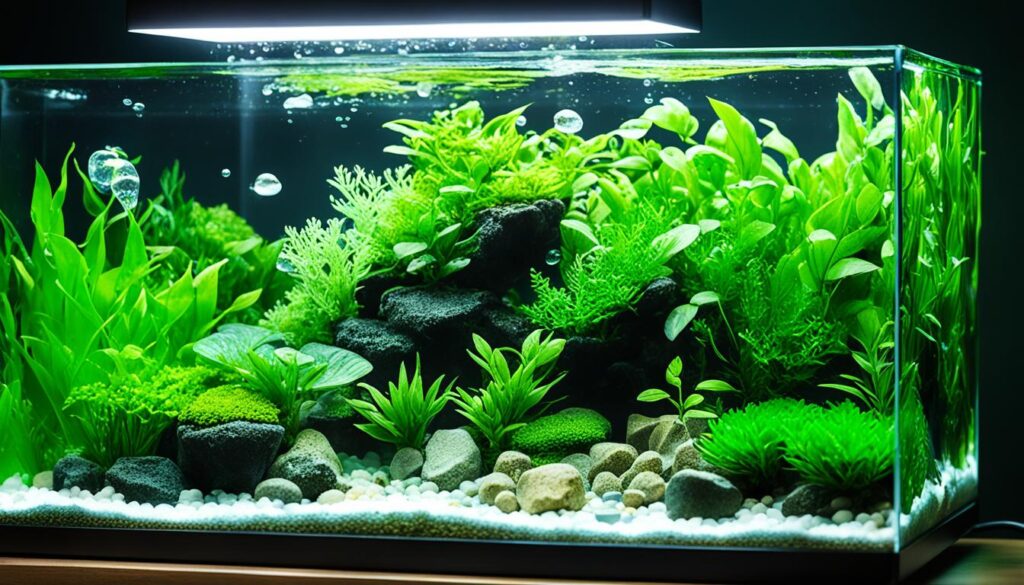
Cycling With Fish
Cycling a tank with fish is a popular method that can be used to establish a balanced and thriving aquarium ecosystem. However, it requires careful monitoring and maintenance to ensure the health and well-being of your fish. Here are the steps for fish-in cycling:
- Set up the tank components: Start by selecting an appropriate tank size and adding the necessary equipment such as filters, heaters, and substrate.
- Add hardy fish: Choose a few hardy fish species, like Zebra Danios or White Cloud Mountain Minnows, that can withstand the cycling process.
- Feed fish lightly: Feed your fish small amounts of food once or twice a day to prevent excess waste and ammonia buildup.
- Test water quality: Regularly test the water parameters using ammonia test strips and multi-test strips to monitor the levels of ammonia, nitrite, and nitrate.
- Perform partial water changes: If ammonia or nitrite levels are detectable, perform partial water changes to dilute these harmful substances and keep the water parameters safe for your fish.
- Complete the cycle: The cycling process is considered complete when you are able to feed your fish normal amounts of food for a week, and ammonia and nitrite levels stay at zero while nitrate levels are above zero.
By following these steps, you can ensure a successful fish-in cycling process and create a healthy environment for your fish to thrive.
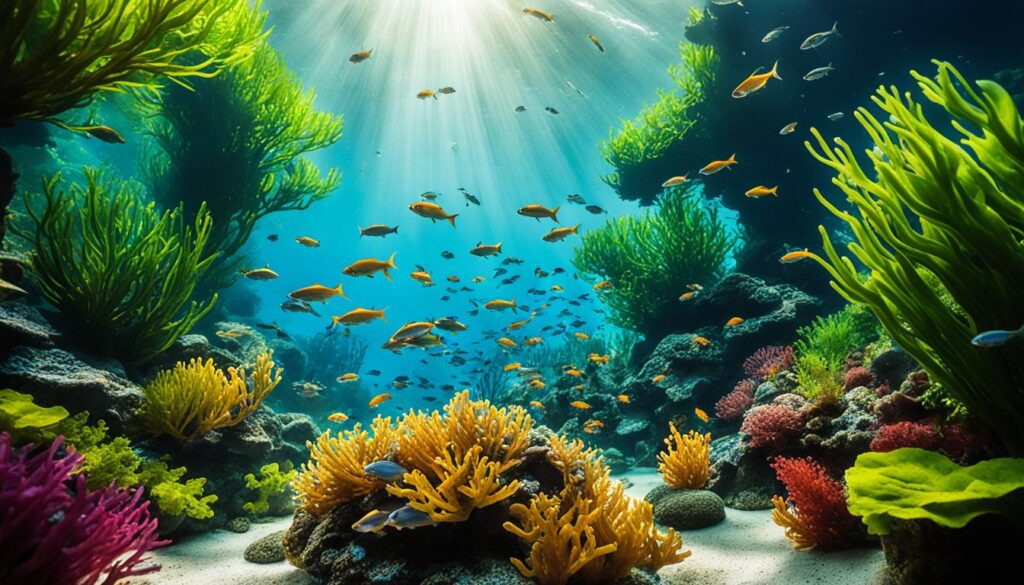
Cycling With Plants
Adding live aquarium plants to your tank while cycling can enhance the natural beauty of your aquatic environment. Not only do plants create a visually appealing landscape, but they also play a vital role in the cycling process.
When cycling with plants, the benefits are twofold. Firstly, plants help absorb the ammonia and nitrate that are produced during the cycling process. This helps maintain water quality and creates a healthier environment for your fish. Secondly, plants contribute to the aesthetics of your tank, providing shelter and habitat for your aquatic pets.
However, cycling with plants can present its own challenges. One of the main challenges is the unpredictability of plant growth. Some plants may establish quickly and flourish, while others may take longer to acclimate and show visible growth. It’s important to be patient and allow the plants to establish themselves before introducing fish to the tank.
During the cycling process with plants, it’s essential to monitor ammonia levels regularly. This can be done using an ammonia test kit. Maintaining optimal water parameters is crucial for the health and well-being of your plants and fish.
Additionally, measuring other water parameters such as nitrite and nitrate levels is also important. These tests can help you gauge the progress of the cycling process and ensure that the tank is ready for the introduction of fish.
Once the plants have established and the water parameters are within the desired range, you can safely introduce fish to your tank. However, it’s still important to monitor water parameters periodically to ensure a stable and balanced ecosystem for your aquatic pets.
Overall, cycling with plants is a rewarding and environmentally-friendly approach to creating a thriving aquarium. By incorporating live plants into your tank, you not only promote the growth of beneficial bacteria but also create a visually stunning underwater landscape for you and your fish to enjoy.
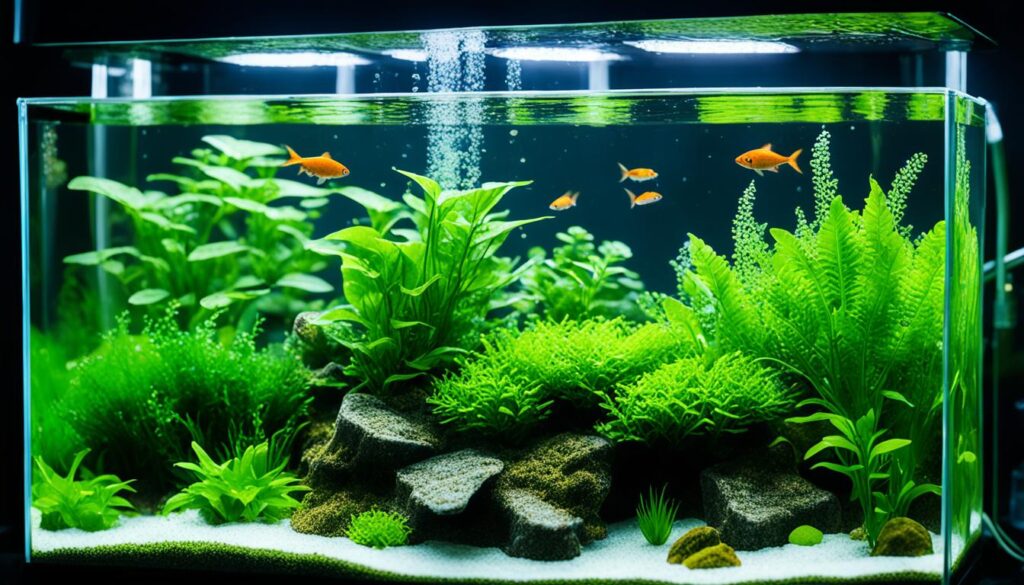
| Benefits of Cycling with Plants | |
|---|---|
| 1 | Enhances water quality by absorbing ammonia and nitrate |
| 2 | Creates a visually appealing and natural habitat for fish |
| 3 | Provides shelter and hiding places for fish |
| 4 | Contributes to a balanced and stable ecosystem |
Conclusion
Cycling a new aquarium with plants is an essential step in creating a thriving aquatic environment for your fish. By following the 7-step guide outlined in this article, you can establish a biologically safe and balanced tank that promotes the growth of beneficial bacteria and ensures the health and well-being of your fish.
Remember to monitor water parameters, regularly test ammonia, nitrite, and nitrate levels, and introduce fish gradually to maintain a stable and harmonious ecosystem. It is crucial to keep a close eye on the ammonia, nitrite, and nitrate levels to ensure they stay within the appropriate range for your fish’s health.
Introducing fish too quickly can disrupt the cycling process and harm the fish. Patience is key when cycling an aquarium, as it can take several weeks for the beneficial bacteria to establish and the nitrogen cycle to fully develop. However, the reward is worth it — a healthy and thriving aquatic environment that provides a beautiful home for your fish to flourish.
Happy cycling!
FAQ
What are the steps for cycling a new aquarium with plants?
The 7 steps for cycling your new aquarium with plants are: 1. Gather the necessary supplies, 2. Set up the tank components, 3. Add ammonia to kickstart the nitrogen cycle, 4. Monitor ammonia and nitrite levels, 5. Test nitrate levels, 6. Wait for plant growth, 7. Introduce fish gradually.
What is aquarium cycling?
Aquarium cycling is the process of creating a biologically safe environment for fish in a new tank. It involves introducing nitrifying bacteria into the aquarium to regulate the nitrogen cycle, which converts toxic ammonia into less harmful substances.
Why is aquarium cycling important?
Aquarium cycling is important for the long-term health and survival of your fish. It allows nitrifying bacteria to establish and populate the biological filters, helping to break down and remove the toxic ammonia produced by fish waste, thus preventing “New Tank Syndrome” and maintaining water quality.
How long does aquarium cycling take?
The duration of aquarium cycling can vary, but it generally takes four to eight weeks. Factors such as tank size, water pH, and temperature can influence the cycling time. Monitoring water parameters and regularly testing ammonia, nitrite, and nitrate levels will determine when the cycle is complete.
What do you need to cycle an aquarium?
To cycle an aquarium, you will need fish food, an aquarium test kit, all the required tank components, and a quality water filter. Having these supplies prepared beforehand will make the cycling process smoother and more efficient.
How can you cycle an aquarium without fish?
Cycling an aquarium without fish is a popular method, especially for beginners. It involves setting up the tank components, checking water pH, adding ammonia to kickstart the nitrogen cycle, monitoring ammonia and nitrite levels, testing nitrate levels, and waiting for plant growth before introducing fish.
How can you cycle an aquarium with fish?
Cycling an aquarium with fish requires careful monitoring and maintenance. The steps include setting up the tank components, adding a few hardy fish, feeding them lightly, regularly testing water quality, performing partial water changes when necessary, and considering the cycle complete when ammonia and nitrite levels are zero and nitrate levels are above zero.
How can you cycle an aquarium with plants?
Cycling an aquarium with plants involves adding live plants to the tank and allowing them to establish and grow. Plants can help absorb ammonia and nitrate, contributing to the cycling process. However, the timing and success of plant growth can vary, so monitoring ammonia levels, measuring water parameters, and waiting for plant growth before introducing fish is important.
